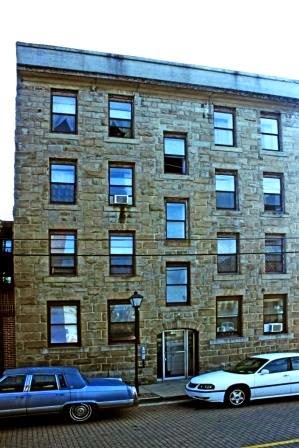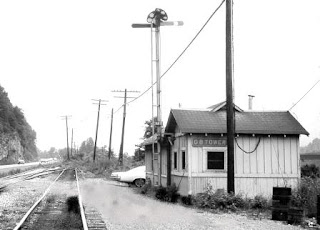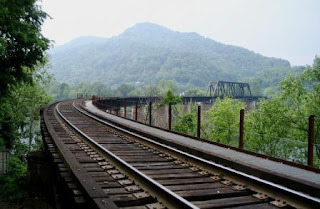~~~~~~~~~~~
Mullens, WV - Milepost 376.7
Sponsored by Tom Marshall
Located at the north end of Elmore Yard is Mullens and the site of the famed “Motor Barn” where from 1925 through the N&W merger to the summer of 1962, all electric locomotives were shopped. When diesels started to arrive in the spring of 1954, they were maintained at Mullens Motor Barn as well. In 2011, the structure was demolished. The famed Winding Gulf branch enters the mainline at Gulf Junction, beside the site of the motor barn.
Tom Marshall Picture
Tom Marshall Picture
VGN caboose 307, class C-10, built by St. Louis Car Company in 1948, is preserved and sits near the Rite Aid Pharmacy at 301 Moran Avenue in the north end of the downtown business district.
Standing just east of the intersection of Moran Avenue and Pineville Road in downtown Mullens is this brick VGN structure. It's build date is unclear except that it was built soon after the fire of 1917 in which the VGN Mullens station and two blocks of downtown buildings were destroyed. Built adjacent to the site of the destroyed station building, this brick building served as a baggage storage building. The town had a very brisk passenger service with six trains a day stopping for a while. When Centralized Traffic Control came to this part of the Virginian after World War II, the dispatcher's office was housed here, controlling trains between Princeton and DB Tower, a distance of 95 miles.
~~~~~~~~~~~~~~~~~
Slab Fork - Milepost 387.9
Sponsored by Bill Johnson
Opening in 1907, Slab Fork was the first coal mine in the Winding Gulf Coal Field. Initially coal was mined from the Beckley seam but later, mine shafts reached the seam of Pocahontas 3 & 4 coal.A trade publication of 1917 reported the company town of Slab Fork hosting over 200 houses for miners and five more for mine officials. Among its amenities were a movie theater, churches, school which operated eight months of the year.The coal company provided land for light farming and teams for preparing it for cultivation.
Ghislain Gerhard Picture
Soaring above the town is Virginian’s massive bridge, 613 feet long and eighty feet high.
~~~~~~~~~~~~~
Oak Hill Station - Milepost 419.3
The Virginian Oak Hill Station does not resemble other Virginian structures for a very good reason. It was built in 1903 by the White Oak Railway, the railroad facility of owner White Oak Coal Company and the Virginian may not have even been an idea in 1903. Virginian leased the station in 1912 and ultimately purchased it 1922. After the VGN/N&W merger of 1959, N&W continued to use the facility until closure in 1983. It was donated to the City of Oak Hill by Norfolk Southern in 1995.
The station, located at the corner of Virginia and Central avenues in Oak Hill, WV, is owned by the city and used by the White Oak Chapter of the National Railway Historical Society. It is painted in Virginian’s standard color scheme of orange with white trim which was used from the inception of the railroad to 1945.
~~~~~~~~~~~~~
The Deepwater Building, Beckley, WV
Served by means of trackage rights over C&O Ry.
Sponsored by John Zuro
Tom Marshall Picture
Heather Reynolds Picture
The Deepwater Building, standing in historic downtown Beckley, West
Virginia at 128 S. Heber Street, was built circa 1904 by the Deepwater Railroad
to be the headquarters of the coal sales office of Loup Creek Colliery of Page
and Beards Fork, WV. H. H. Rogers was a primary owner of both the Deepwater
Railway, which became the Virginian Railway in April 1907, and Loup Creek
Colliery, so the connection is obvious. In 1910 a devastating fire consumed
nearly all of downtown Beckley, including thirty businesses, save for the stone, four story Deepwater Building. Later in that same year the Virginian Railway sold the structure to a partnership of two Beckley
men, a lawyer and a doctor, who rented out the unused profession space to
others, including the American Red Cross and the Citizens Bank of Beckley. In
1919 a fire destroyed some of the interior of the structure. In 1920, the
partnership in turn sold the building to the United Mine Workers Union to serve
at headquarters of Distract 29. In the building's second century of life, it offers residential apartments.
~~~~~~~~~~~~~~~~~
Page - Kincaid - Milepost 426.8
Sponsored by Doug Bess
This 1906 view shows much of Page under construction. At the top, the station is being built and in the upper left, the branch to a coal mine is being graded. Greg Elam Collection
Page, West Virginia was named for William. N. Page, a civil engineer
whose idea it was to buy a logging railroad and extend it south from the Kanawha River to untapped
coal deposits. He convinced H.H. Rogers of the validity of his idea and thus,
the two men began what would become the Virginian Railway. C.H. Slayton, Jr, in his book “Virginian Railway Early Years,” states
that Page was the operating headquarters for the Deepwater Railroad, 1905-1906.
Page was also the headquarters of the Loup Creek Colliery Company which built a
company store and a library. Page was a
medium sized marshalling yard located just 8.2 miles from the very end of the
railroad at DB tower. There was a wooden three track engine house with a back
shop attached on the compass west side. When Princeton received a new 120 foot
long turntable in 1919, the old 100 footer was strengthened and moved to Page.
In 1939, it was removed and replaced by a wye on which locomotives would be
turned. The old 100 foot turntable saw
another life as a highway bridge at Oceana.
In 1967, Doug Bess took this pitcure looking eastbound on the former VGN mainline.
By 1990 all coal mining
at Page had ceased and the countryside began to revert back to nature. However,
there was still coal to be mined and in 2007 Frazier Mining Company constructed
a flood loading facility, using a system of conveyors to bring in coal from two
sources; a mountain top strip mine as well as from a deep mine. By flood loading, entire trains of empty
hoppers are loaded while passing under the loader at a slow speed.
Dr. Gerry Albers made this picture of a train being flood laded in October 2011.
~~~~~~~~~~~~~~~~~
Deepwater Area - Milepost 434
Sponsored by Gerry Albers
West Deepwater -August Thieme Picture, AWiley Collection
The VGN Heritage Trail Historical Marker for Deepwater is located at the Church of Living Water, formerly Deepwater United Methodist Church. The church is on the south side of route 61, Deepwater, and on the east side of the VGN’s connecting track to the C&O. The attractive church sits on the side of hill, fronting 61 with the VGN on a side.
Ghislain Gerard Picture
· C&O Deepwater - Down the VGN trackage which passes beside the church, toward the river, is the site of VGN’s connection with the Chesapeake & Ohio railroad and yard. When built, this trackage was the mainline until the line connecting with New York Central on the north side of the Kanawha River was completed in 1931. Today, it is an active NS/CSX connection and yard.
Scott Greathouse Collection
· VACO Jct - Going the opposite direction up the railroad from the church is VACO Junction, created in 1931 when the NYC connection was completed.
· Deepwater Tunnel - Just a very short walk along 61 to the west is Virginian’s bridge over route 61, above which VGN’s shanty shelter for West Deepwater stood. From the site of West Deepwater looking railroad east, the 491.5 foot long Deepwater Tunnel can be seen.
· DB Tower - Looking railroad west is the Virginian’s bridge over the Kanawha River, 1920.5 feet in length with VGN’s milepost 435 on the far, north side of the river. DB Tower stood within one hundred yards of the end of the Kanawha River bridge and was VGN’s connection with the New York Central railroad. It can be reached from Deepwater by traveling west on route 61 to route 6, turn right to cross the river on the highway bridge over and right onto route 60 east.
This view is from the NYC end of the Kanawah River Bridge. The NYC is behind the photographer and the C&O runs along the far side of the Kanawha River.
Trains leaving the Kanawha River Bridge see this view. DB Tower was just beyond the trees on the left side.
~~~~~~~~~~~~
Charleston, West Virginia
From the very early years of Virginian’s passenger train service in 1909 to January 24, 1952, the western terminus for passenger trains was in Charleston, West Virginia, a distance of 466 miles. From October 10, 1909 to 1931, Virginia’s trains called on Charleston using the Chesapeake & Ohio railroad station. Situated on McCorkle Ave. SE (route 61) and beside South Side Bridge, the C&O station pictured above was built in 1905.
Ross Hunter Collection
After 1931, when the VGN Kanawha River bridge was completed, VGN’s passenger service to Charleston was to the New York Central station. The NYC was at the end of Brooks Street and in the 1200 block of Smith Street in downtown Charleston. Baltimore & Ohio Railroad’s passenger trains also called on the NYC station. In the 1908 postcard view above, the view is looking east and Interstate 64 would be built to the left of the railroad.
Ross Hunter Collection
The NYC station whose build date is unknown, had a very interesting history itself. The Ohio Central had built eastward along the north bank of the Kanawha River to reach Charleston in the 1800’s but it went into receivership in 1883 and was sold to the Kanawha & Ohio in 1885. In 1889 the K&O went into receivership and was rechartered as the Kanawha& Michigan. The K&M then extended east of Charleston to Gauley Bridge by buying the Charleston & Gauley Bridge Railroad. The K&M was an independent operation, but was controlled by the Toledo & Ohio, later the Hocking Valley. The C&O acquired a controlling interest in the Hocking Valley , however in 1914 the US District Court forced the C&O to sell the K&M under terms of the Sherman Anti-Trust Act. Control passed back to the Toledo & Ohio Central which was leased by New York Central in 1922. Thanks to Ross Hunter for the NYC station details.











trmimp%2Bsml.jpg)














